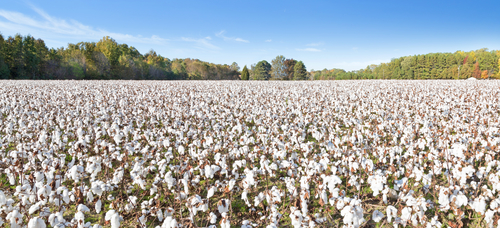by Ashley Hungerford and Erik O’Donoghue, USDA Economic Research Service
What Is the Issue?

The 2014 Farm Act changed the structure of several commodity support programs for agriculture. Before, cotton was a covered commodity and eligible for support payments. Now, if cotton producers want Government-sponsored protection in addition to preexisting Federal crop insurance programs, like Revenue Protection (RP), they must purchase one of the shallow-loss insurance policies, the Supplemental Coverage Option (SCO) or the Stacked Income Protection Plan (STAX). Since these programs were first implemented in 2015, this report explains the mechanics of the two programs and provides estimates of their potential for reducing cotton producers’ revenue risk.
What Did the Study Find?
This report analyzes how different realized yields, harvest prices, subsidy levels, and program guarantees affect the outcomes of SCO and STAX under expected yields and projected prices for 2014.
- When STAX indemnity payments are isolated from any other insurance programs, STAX reduces revenue risk by an estimated 2 to 10 percent depending on the area loss trigger (ranging from 75 to 90 percent of the expected revenue for the county) selected by the farmer. SCO cotton indemnity payments, alone, reduce revenue risk by an estimated 7 percent.
- In many cases, STAX has a lower farmer-paid premium than SCO while providing higher indemnity payments. The lower farmer-paid premium for STAX is caused by the higher premium subsidy provided for STAX compared to SCO.
Since upland cotton is grown throughout the southern United States, this report examines how SCO and STAX affect producer revenue across these disparate areas.
- The analysis of three cotton-producing counties (low, medium, and high risk) shows that higher revenue risk (often a function of yield variability) is closely associated with lower revenue. The high-revenue risk county receives lower average net payments from SCO and STAX than the lower risk county. The lower average payment for the high-revenue risk county is cause by the lower expected revenue for the high-revenue risk county, which leads to a lower guarantee and smaller maximum payments compared to the lowrevenue risk county.
- Producers in low-risk counties receive greater risk reduction benefits from STAX and SCO than from Revenue Protection (RP) with (the most commonly chosen) 70 percent coverage level. Producers in high-risk counties receive greater risk reduction benefits from the RP policy, which insures against more significant losses.
- The majority of cotton-producing counties with high revenue risk are located in Texas. These counties in Texas also have the greatest risk reduction when RP (70 percent coverage) is applied in combination with SCO or STAX. The pattern of risk reduction for counties across the United States is similar for SCO and STAX, though the risk reduction afforded by STAX is higher.
Finally, the report examines the 2015 enrollment of STAX and SCO.
- STAX enrollment was approximately 20 percent (12,000 policies) of what RP enrollment was in 2015 (59,000 policies). Of the 8.5 million acres planted to upland cotton, 7 million acres were covered by RP and 2.5 million acres were covered by STAX.
- Only 120 SCO policies were purchased by cotton producers in 2015. The popularity of STAX over SCO is in keeping with simulation results indicating a higher expected payment under STAX.
- As the share of cotton operations among total crop operations in a county increases, so does the proportion of STAX policies to cotton operations. As such, STAX is more intensively used in counties where on-farm income from cotton is relatively higher.
How Was the Study Conducted?
This study contains both (1) simulation exercises examining average payments and risk reduction under STAX and SCO, and (2) regression modeling investigating STAX enrollment in 2015.
For our simulation study, county yield data for all counties that produced upland cotton between 1975 and 2013 are from USDA’s National Agricultural Statistics Service. Prices for cotton (1975-2013) are from USDA’s Risk Management Agency (RMA). Only counties with continuous cotton production (recorded every year are included in the analysis, leaving 151 cotton-producing counties, which represent 67 percent of U.S. cotton acres in 2013. County base premium rates for Federal crop insurance policies are also from RMA.
In this analysis, yields at the national, State, and county levels are simulated in order to estimate revenue along with payments from STAX and SCO. Simulation is needed because STAX and SCO are new programs. Relying on the realized revenues from 2015 would not provide robust average estimates for payments. The historical yields and prices collected are used to estimate averages and give likely ranges for variables. Each of 10,000 simulated observations contains a simulated national market price and simulated yields for each county in the data set. The county-level simulated yields are adjusted to reflect the idiosyncratic—i.e., farm-specific—risk of a representative farm of a given county.
With the representative farm yield, county yields, and market price, revenue for the representative farm and county can be calculated. If the revenue is below the guarantee for STAX or SCO, a payment is calculated for the respective program; otherwise, the gross payment is zero. The payments and revenues for each representative farm and county are calculated for each of the 10,000 simulated observations. With simulated revenues and payments, measures of risk reduction can be calculated.
Using the RMA’s Summary of Business to collect data on STAX policies sold and the 2012 Agricultural Census for data on cotton operations and total crop operations, regression modeling examines the relationship between the market penetration of STAX and the concentration of cotton operations (out of total crop operations) per county. A Tobit model is used to account for the large number of counties where cotton operations are present but no STAX policies were purchased.
Read the full Federal Crop Insurance Options for Upland Cotton Farmers report.










